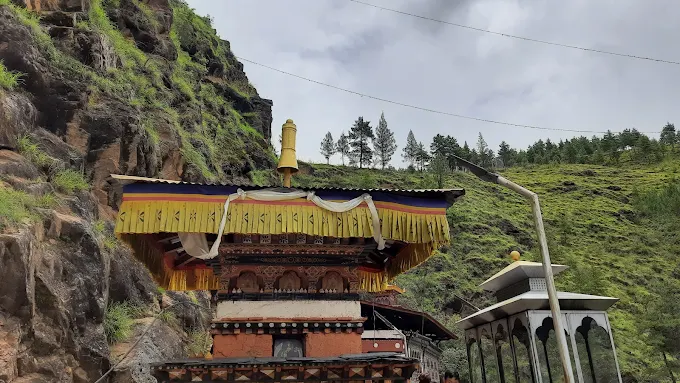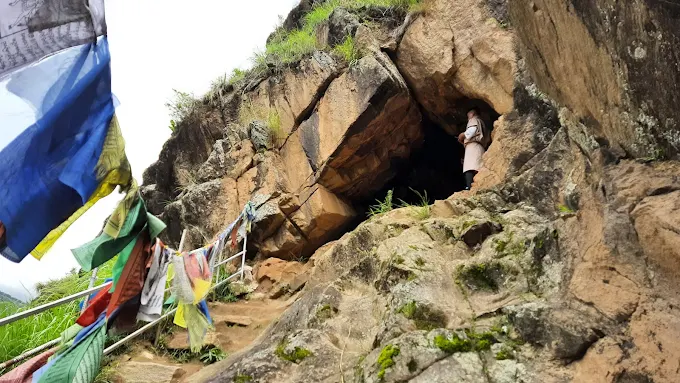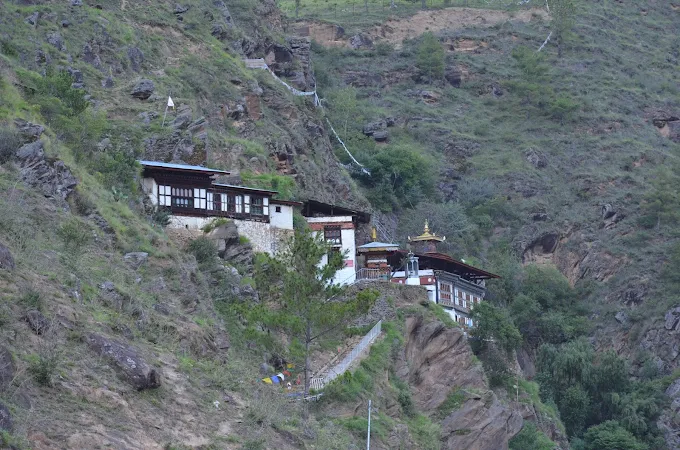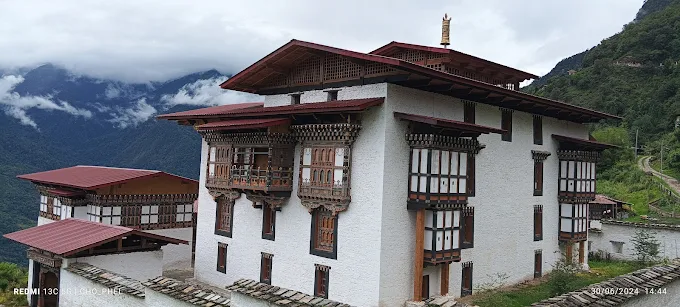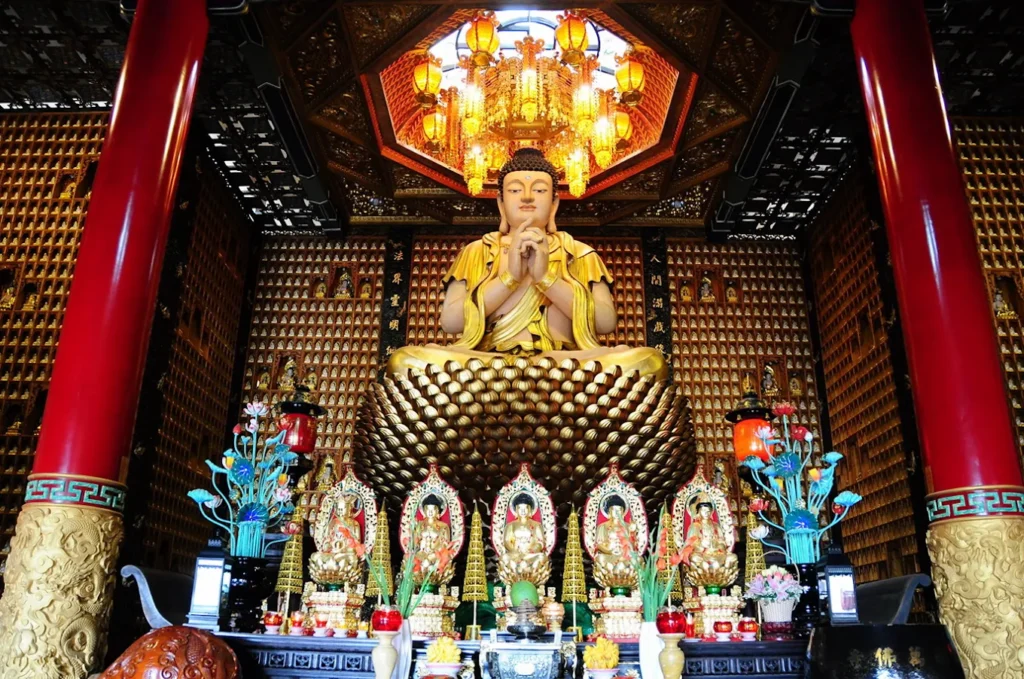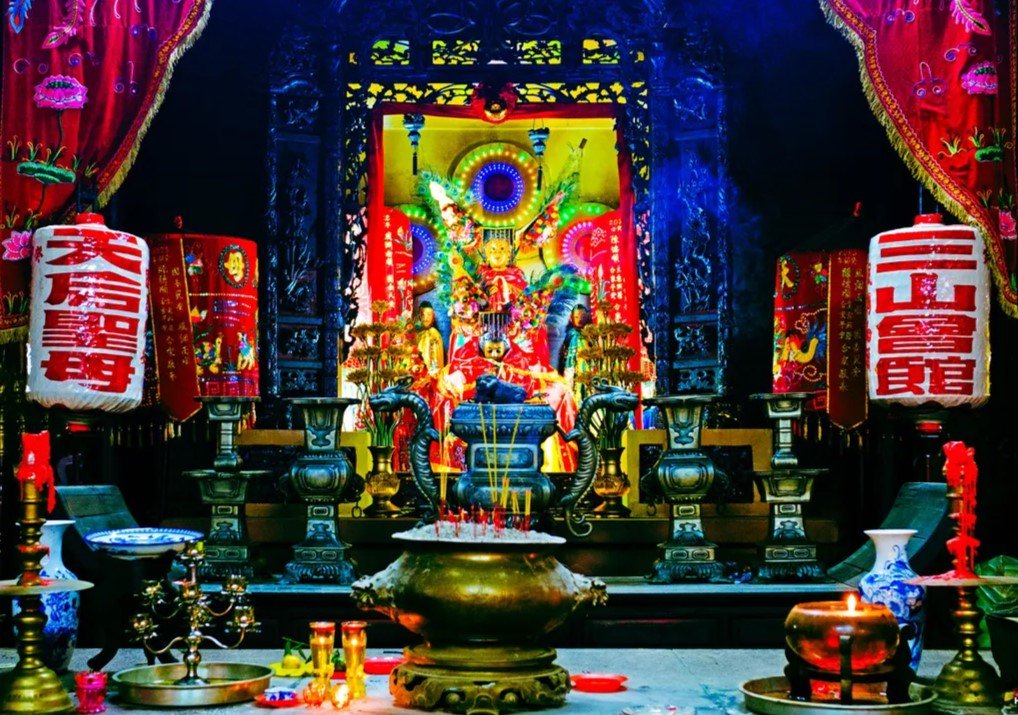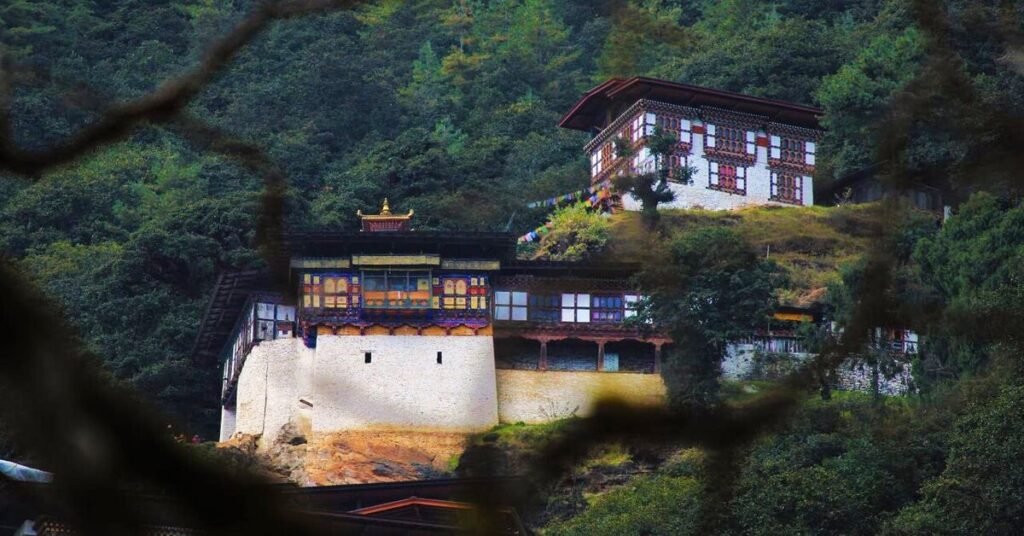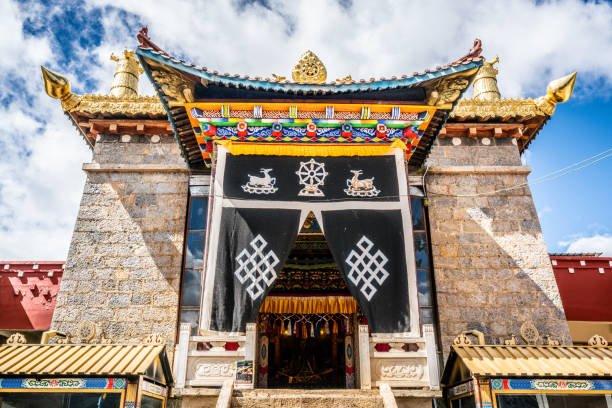Tandin Ney Lhakhang: Thimphu’s Sacred Caves of the Horse-Headed Deity
High above Thimphu Valley, where the Wangchu River carves a gentle path, Tandin Ney Lhakhang clings to a mountainside near Yangchenphug School. This sacred lhakhang [temple], rooted in the Drukpa Kagyu tradition, honors Hayagriva [Tandin], the horse-headed deity whose fiery form appeared to Phajo Drugom Zhigpo in the 13th century. The temple’s meditation caves, once sheltering Guru Rinpoche in the 8th century, hum with spiritual energy, their walls adorned with statues of Buddha, Hayagriva, and a speaking Tara. Stone paths wind through rhododendron forests, leading pilgrims to a serene complex where prayer flags flutter against the Himalayan breeze. Built to fulfill a prophecy, Tandin Ney Lhakhang draws devotees and travelers seeking the transformative power of its ancient caves, a testament to Bhutan’s enduring Buddhist legacy.
Whispers of Hayagriva: Overview and Significance
Tandin Ney Lhakhang, nestled in Thimphu District, is a spiritual beacon tied to the Drukpa Kagyu lineage and the legacy of Guru Rinpoche and Phajo Drugom Zhigpo. Its meditation caves and sacred statues embody Bhutan’s Vajrayana heritage, offering a tranquil retreat for pilgrims and a window into the kingdom’s cultural depth for global visitors.
Historical Roots and Legacy
Tandin Ney Lhakhang traces its origins to the 13th century, when Phajo Drugom Zhigpo, a key figure in spreading Drukpa Kagyu teachings, meditated in its caves. Legend recounts Phajo witnessing a cliff ablaze, revealing Hayagriva’s mandala, prompting him to establish the temple. Guru Rinpoche, in the 8th century, also meditated here, marking the site as sacred. In the 20th century, a treasure revealer’s vision led to the construction of Drubkhangs [retreat buildings], solidifying its modern form. The temple’s history reflects Bhutan’s unification under Drukpa Kagyu influence.
- Key Milestones:
- 8th century: Guru Rinpoche meditates in Tandin Ney caves.
- 13th century: Phajo Drugom Zhigpo establishes the temple.
- 20th century: Drubkhangs built, enhancing the complex.
Cultural and Spiritual Significance
As a Drukpa Kagyu site, Tandin Ney Lhakhang embodies Mahamudra [Great Seal], a practice seeking the mind’s innate clarity through meditation. Its caves, believed to enhance meditative accomplishments, draw monks and lay practitioners. The temple’s association with Hayagriva, a wrathful deity subduing negativity, underscores its protective role in Bhutanese spirituality. Its proximity to Thimphu makes it a vital cultural link, attracting tourists and reinforcing Bhutan’s Gross National Happiness ethos.
- Cultural Roles:
- Preserves Drukpa Kagyu teachings through meditation retreats.
- Enhances Thimphu’s spiritual tourism, alongside sites like Tango Monastery.
- Symbolizes Bhutan’s Buddhist resilience amid modernization.
Community and Global Connections
Tandin Ney Lhakhang serves Thimphu’s residents through prayers and pilgrimage, with locals visiting on auspicious days like Tara’s day. Monks guide visitors, sharing the site’s history, fostering cultural exchange. Internationally, it draws pilgrims from India, Nepal, and Western countries, captivated by its caves and serene ambiance. Supported by Bhutan’s tourism policies, the temple bridges local devotion with global curiosity, enriching Thimphu’s cultural tapestry.
- Community Impact:
- Hosts communal prayers, strengthening local bonds.
- Engages global visitors through guided tours.
- Sustains Bhutanese heritage via monastic presence.
The temple’s ancient caves, echoing Phajo’s vision, invite exploration of its sacred architecture, where stone and spirit intertwine to honor Hayagriva’s legacy.
Caves of Contemplation: Architectural and Spiritual Features
Tandin Ney Lhakhang’s modest yet sacred design centers on its meditation caves, carved into the mountainside above Thimphu. Enhanced by stone paths and Drubkhangs, the complex blends Bhutanese artistry with natural splendor, creating a haven for spiritual practice.
Iconic Design and Structures
The temple’s architecture is defined by its caves, accessible via stone paths with railings, improved in recent years for safety. The lower complex houses meditation caves, while the upper complex features a shrine room and Drubkhangs, built in the 20th century. Whitewashed walls and prayer flags frame the site, harmonizing with the rhododendron-laden landscape. A chorten [stupa] near the caves enshrines relics of Khando Sonam Peldon, Phajo’s consort, adding historical depth.
- Design Highlights:
- Meditation caves, naturally formed, with stone path access.
- Drubkhangs with whitewashed stone and wooden beams.
- Chorten enshrining Khando Sonam Peldon’s relics.
Sacred Statues and Relics
The shrine room houses statues of Buddha, Hayagriva, Guru Rinpoche, and Tara, the latter famed for reportedly speaking. Hayagriva, the horse-headed deity, is central, crafted in bronze with fierce features, symbolizing the subjugation of obstacles. Guru Rinpoche’s statue, gilded and serene, reflects his foundational role. A cave rock bearing 21 Tara manifestations, yet to fully emerge, adds mystical allure. The Buddha statue anchors the space with calm wisdom.
- Statue Details:
- Hayagriva: Bronze, ~1 meter, with fiery expression.
- Guru Rinpoche: Gilded, central to Drukpa Kagyu devotion.
- Tara: Stone, linked to a speaking legend, with 21 manifestations.
Artistry and Environmental Harmony
Bhutanese artisans crafted the temple’s minimal yet vibrant details, using local stone and timber for sustainability. Prayer flags and simple frescoes of auspicious symbols adorn the Drubkhangs, reflecting Zorig Chusum [13 traditional crafts]. The site’s integration with the mountainside, surrounded by oak and rhododendron, aligns with Bhutan’s eco-conscious ethos, preserving the natural serenity that enhances meditation.
- Artistic Features:
- Prayer flags with printed mantras, fluttering in the breeze.
- Simple frescoes of lotus and jewel motifs.
- Eco-friendly design, minimizing environmental impact.
The temple’s sacred caves and statues, steeped in Drukpa Kagyu tradition, prepare visitors for its spiritual practices, where devotion meets contemplation.
Practices of the Sacred Cliffs: Rituals and Practices
Tandin Ney Lhakhang’s spiritual life centers on meditative retreats and devotional practices, rooted in Drukpa Kagyu traditions. While specific rituals are less documented, the temple’s caves and statues inspire a vibrant, if understated, ritual culture.
Daily and Unique Rituals
Monks and lay practitioners meditate in the caves, focusing on Mahamudra to cultivate mental clarity. Devotees offer butter lamps before Hayagriva’s statue, seeking protection from obstacles. Circumambulation of the chorten and prayer wheel spinning are common, accumulating merit. The temple’s caves, used for retreats, are unique, believed to amplify meditative power due to Guru Rinpoche’s presence.
- Daily Practices:
- Meditation sessions in caves, ~2–3 hours.
- Butter lamp offerings for protection and wisdom.
- Circumambulation and prayer wheel spinning.
Festival Traditions
The temple likely hosts prayers on auspicious days, such as Guru Rinpoche Day (10th lunar day monthly), though specific festivals are unconfirmed. Visitors report increased activity on Tara’s day (8th day of the 4th Bhutanese lunar month), with prayers honoring the speaking Tara statue. These events, distinct from daily practices, draw local pilgrims for communal devotion.
- Festival Highlights:
- Tara’s Day: Prayers and offerings, unconfirmed scale.
- Guru Rinpoche Day: Likely mantra recitations, pending verification.
- Limited public events, emphasizing meditative focus.
Community and Visitor Engagement
The temple engages Thimphu’s community through prayers and pilgrimage, with monks guiding visitors on the site’s history. Tourists join circumambulation or meditate in caves, fostering cultural exchange. Local students visit for educational tours, as seen on Tara’s day, strengthening community ties. The temple’s accessibility encourages both devotion and exploration.
- Engagement Activities:
- Guided tours by monks, ~20–30 minutes.
- Visitor participation in circumambulation.
- Educational visits for local youth.
The temple’s meditative practices, though subtle, guide visitors toward practical insights, ensuring a seamless journey to its sacred cliffs.
Ascending to Tandin Ney: Visitor Information
Tandin Ney Lhakhang, tucked above Yangchenphug School, offers a serene escape for travelers. Its accessibility, cultural etiquette, and surrounding attractions make it a compelling stop in Thimphu.
Navigating the Temple
Located in Thimphu District, the temple is a 15–20-minute drive from Thimphu town, across the Wangchu River. Follow the road past Yangchenphug School to a quiet path leading uphill. Stone paths with railings guide visitors to the lower caves and upper complex, a 10–15-minute walk from parking. The Buddha Dordenma statue is visible across the valley, aiding orientation.
- Navigation Tips:
- Drive from Thimphu via Yangchenphug School road.
- Look for signs to Tandin Ney Lhakhang.
- Expect a 10–15-minute walk from parking.
Practical Details and Etiquette
The temple is open daily from 8 AM to 5 PM, with no entry fee, though donations are welcomed. Visitors must dress modestly (long sleeves, no shorts), remove shoes before entering the shrine, and avoid photography inside. Silence phones and respect meditative spaces. The full address is Tandin Ney, Thimphu District, Thimphu 11001, Bhutan. Accessibility is limited due to steep paths and steps.
- Logistics:
- Address: Tandin Ney, Thimphu District, Thimphu 11001, Bhutan.
- Hours: 8 AM–5 PM, daily.
- Transport: Taxi (~Nu 150) or private vehicle.
- Etiquette: No indoor photography, dress conservatively.
Immersive Experiences and Surroundings
Visitors can light butter lamps (~Nu 20) or meditate in the caves, guided by monks. The view of Thimphu Valley from the caves is breathtaking. Nearby, the Buddha Dordenma (15-minute drive) offers panoramic vistas, while Changangkha Lhakhang (20-minute drive) provides further cultural immersion. The Weekend Market (25-minute drive) showcases local crafts.
- Immersive Tips:
- Light a butter lamp for blessings.
- Meditate in the caves for a spiritual experience.
- Visit Buddha Dordenma and Changangkha Lhakhang nearby.
The temple’s serene paths and sacred caves invite deeper exploration of its philosophical and cultural significance, connecting visitors to Bhutan’s spiritual essence.
Wisdom of the Caves: Cultural and Spiritual Insights
Tandin Ney Lhakhang offers profound insights into Drukpa Kagyu philosophy, with its caves and deities symbolizing transformation and resilience. Its role in Thimphu’s spiritual landscape underscores its enduring relevance.
Philosophical Foundations
The temple’s practices center on Mahamudra, teaching that the mind’s true nature is luminous and free from delusion. Hayagriva’s wrathful form represents the destruction of negativity, guiding practitioners toward liberation. These concepts, shared through monk-led talks, align with Bhutan’s focus on mindfulness and compassion, accessible to visitors seeking spiritual clarity.
- Key Concepts:
- Mahamudra: Non-conceptual meditation for enlightenment.
- Hayagriva: Symbol of transformative protection.
Cultural and Symbolic Depth
The chorten enshrining Khando Sonam Peldon’s relics symbolizes devotion and continuity, while the caves represent meditative purity. Tara’s speaking statue and 21 manifestations embody compassion and potential enlightenment. These symbols, explained during tours, deepen visitors’ understanding of Bhutanese Buddhism’s dynamic imagery.
- Symbolic Elements:
- Chorten: Symbol of devotion and historical legacy.
- Caves: Emblems of meditative accomplishment.
Community and Environmental Resilience
Tandin Ney fosters community through prayers and educational visits, uniting locals and tourists. Its eco-conscious design, using natural stone and minimal land disruption, reflects Bhutan’s environmental ethos. Youth engagement, as seen with student visits, ensures cultural continuity amidst Thimphu’s growth.
- Resilience Efforts:
- Communal prayers, strengthening social ties.
- Sustainable design, preserving natural serenity.
The temple’s caves and symbols resonate with themes of transformation and harmony, inviting visitors to experience its sacred power.
Why You Have to Get to Tandin Ney Lhakhang
Tandin Ney Lhakhang is a must-visit for its mystical caves and profound Drukpa Kagyu heritage. Tucked above Thimphu, its meditation caves, once home to Guru Rinpoche and Phajo Drugom Zhigpo, pulse with spiritual energy. Statues of Hayagriva, Buddha, Guru Rinpoche, and the speaking Tara radiate transformative power, while stone paths and prayer flags create a serene retreat. The temple’s role in fostering meditation and community resilience makes it a cultural gem, drawing pilgrims and travelers alike. As rhododendrons bloom and the Wangchu River glints below, Tandin Ney Lhakhang beckons you to explore Thimphu’s sacred cliffs, where Bhutan’s spiritual past and present converge in quiet awe.
